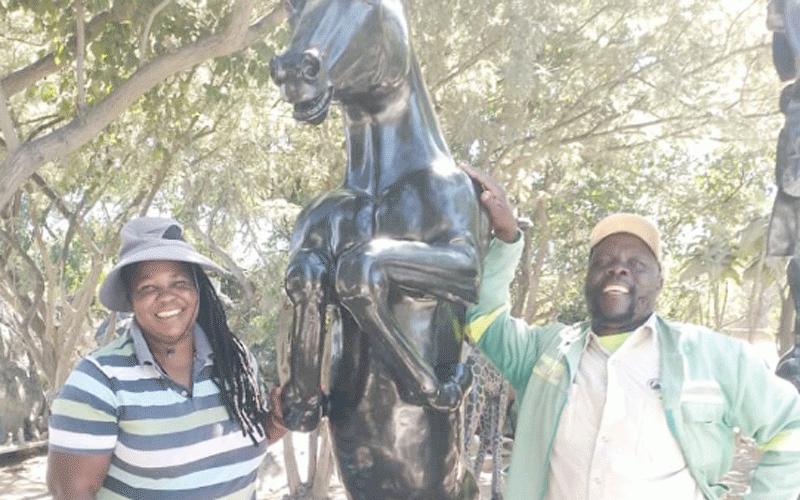Africa-Press – Zimbabwe. VISUAL artists Chango Chitoko and Americk Kambiri put up a formidable creative act as they engraved and embossed a whinnying huge horse figurine named Neighing Horse Monument as a symbol for cultivating vigilance and a warning for a possible foreseen danger.
Horses are arguably the most expensive tamed animal which grazes on the lawn and consumes large amounts of hay and fodder.
They have a deep connection with humans and provide them with services like horseback rides, races, among others.
Chango and Kambiri, who are based at the Chitungwiza Arts Centre, said the horse had inspired people’s innovations which include horse chariot races, horse races, Ezamabhiza Dance, horse kick (Karate) and majestic marches, among others.
“The Neighing Horse Monument stands for a horse which is a very obedient and friendly animal and has the strength to help humans pull huge amounts of weight, including travelling long distances. A horse helps large-scale farmers when they inspect their crops and cattle. It is a timeless symbol of power, freedom and elegance and stands tall on two legs as if it’s breaking free from the shackles of gravity.
“When a horse stands on two legs to see things happening at a distance, it neighs to warn of danger and, in most cases, it advises its master or its group of impending danger. Horses are faithful steeds for warriors and royalty, carrying them into battle and across vast expanses. The amazing gallops often cause lots of excitement, especially in a betting horse race,” they said.
Kambiri added that the horse wins races despite carrying huge weights and sustaining injuries in the process. Their huge spring stone is suitable for both indoor and outdoor exhibitions.
The most amazing thing about the Neighing Horse Monument is its asymmetric balance and attention to detail on the pony’s hair, tail, eyes, teeth, muscles and a hyper-realistic posture. Kambiri has, over the past two decades, produced globally-selling pieces on stone types like spring, opal, hyena, leopard rock and lapidolite. He has got formidable talent in both fine and abstract art and is getting widely popular for hyper-realistic art in the form of portraits.
Chitoko said it took them more than five months to bring to life the Neighing Horse Monument. Chitoko is popular for carving meticulous wildlife semi-abstracts and fine art renditions, including creations of the hornbill birds, giraffes, women and their traditional roles, hunters and collaborations on the big five and the Neighing Horse Monument.
Chitoko, Simelokuhle Zibengwa, Lorraine Mamvura, Tracy Chatsama, Rachel Ellon and Patience are the six female visual artists who made it to the 50 finalists out of the over 170 entries that submitted for the recently held Cecil John Rhodes Competition. Tendai Gwaravaza, chairperson, said the Chitungwiza Arts Centre provided imaginative responses to the Cecil John Rhodes Visual Arts Competition and the selected entries were expressions on the liberation war and independent Zimbabwe. He said artistic freedom is a benchmark for human rights and visual artists are emblematic of the freedoms of will and expression in Zimbabwe. Wallace Mukanga, who is popular for found objects and metal craft artefacts, won the Cecil John Rhodes Visual Arts Competition through his creation on spring stone. Mukanga will join other renowned sculptors from across the world at the Oxford University Cecil John Rhodes Visual Arts competition later in the year.
Tendai Gwaravaza, chairperson of Chitungwiza Arts Centre, said the centre’s participation in competitions was a show of creative confidence and a search for international markets.
Visual artists have been, for a long time, longing for the good old days when international tourists used to flock to the Chitungwiza Arts Centre, where they made bulk purchases of Shona Stone Art.
For Chitoko and Kambiri, the Neighing Horse Monument is their tangible and realistic hope for a disruptive entry into the world of competitive visual arts, where there are household names like Dominic Benhura, Richard Mupumha, Eckel Nyamhondoro and Tago Tazvitya, among others.
“I urge all the youth and aspiring visual artists to work tirelessly without giving in to pressure. The horse uses its strength to carry heavy loads and deliver them to their final destination in perfect order without resorting to cheating,” Chango said.
For More News And Analysis About Zimbabwe Follow Africa-Press






